Dinosaurs: Their Lives, Their Deaths and Their Evolution!
by Dr. Bob Gardner
Department of Mathematics
Department of Physics and Astronomy
Institute of Mathematical and Physical Sciences
East Tennessee State University
The Timeline
The Earth and solar system condensed out of a giant cloud of gas and dust
(called the solar nebula) about 4.6 billion years ago.
 The young Earth was very hot and was hit by many smaller objects which were
orbiting around in the early solar system.
The young Earth was very hot and was hit by many smaller objects which were
orbiting around in the early solar system.
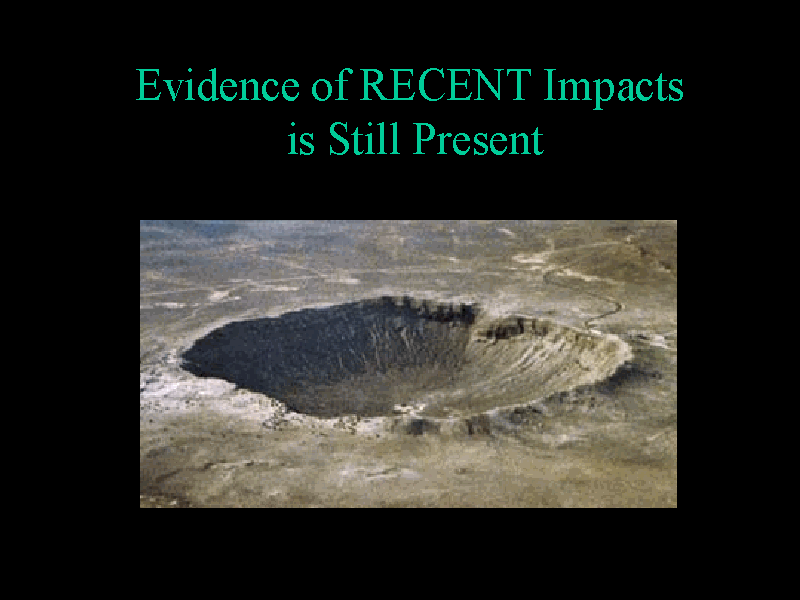 The Earth
continued cooling and after about a billion years, the first forms of life
arose. These first living things were bacteria and primitive algae. In fact,
these first organisms are the ancestors of all living things on our planet
today, including you and me!
The Earth
continued cooling and after about a billion years, the first forms of life
arose. These first living things were bacteria and primitive algae. In fact,
these first organisms are the ancestors of all living things on our planet
today, including you and me!
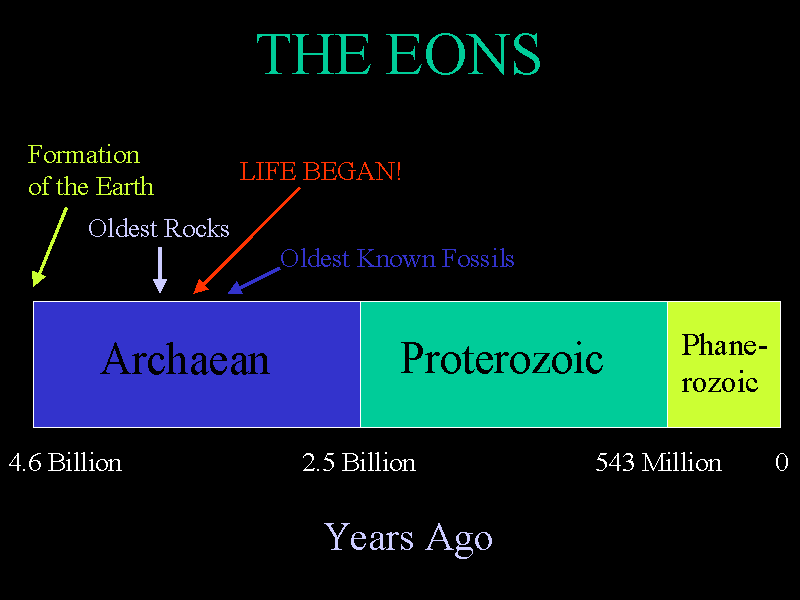 Since the history of the Earth is so long (4.6 billion years), geologists break
the time period up into smaller pieces. The largest of these slices of time
is called an eon. The Archaean Eon lasted from 4.6 to 2.5 billion
years ago. The Proterozoic Eon lasted from 2.5 billion years ago until
543 million years ago. The final eon is the Phanerozoic Eon which
started 543 million years ago and continues today.
Since the history of the Earth is so long (4.6 billion years), geologists break
the time period up into smaller pieces. The largest of these slices of time
is called an eon. The Archaean Eon lasted from 4.6 to 2.5 billion
years ago. The Proterozoic Eon lasted from 2.5 billion years ago until
543 million years ago. The final eon is the Phanerozoic Eon which
started 543 million years ago and continues today.
The oldest rocks found on Earth date from the Archaean and are 4 billion years
old.
The evolution of the first life forms is thought to
have occurred at around 3.5 billion years ago.
The oldest known fossils are
calcareous structures called {\it stromatolites} and were produced by
cyanobacteria.
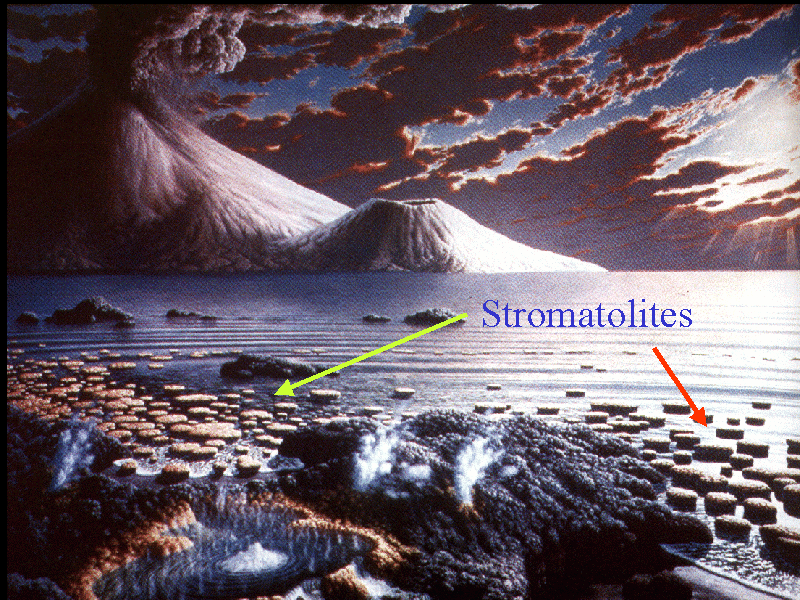 They were found in Australia and date from 3.4 billion years ago.
The Archaean Eon is marked mostly by the absence of fossil life, however.
They were found in Australia and date from 3.4 billion years ago.
The Archaean Eon is marked mostly by the absence of fossil life, however.
The Proterozoic Eon includes the presence of several life forms, but only of
the simplest kinds (mostly single celled). Sometimes the Archean Eon and the
Proterozoic Eon are together called the Precambrian.
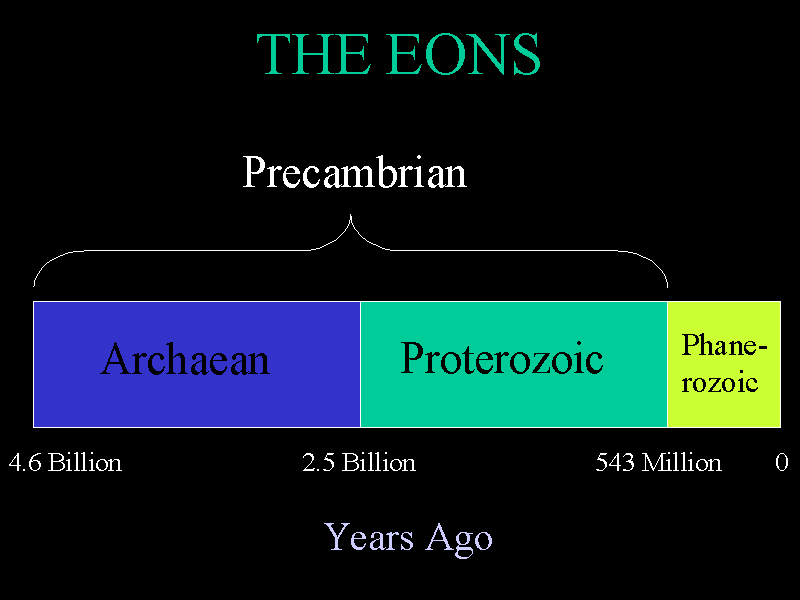 But if we are interested in dinosaurs, then we
have to look much, much farther ahead in time.
But if we are interested in dinosaurs, then we
have to look much, much farther ahead in time.
The Phanerozoic Eon is divided into three blocks of time called {\it eras}.
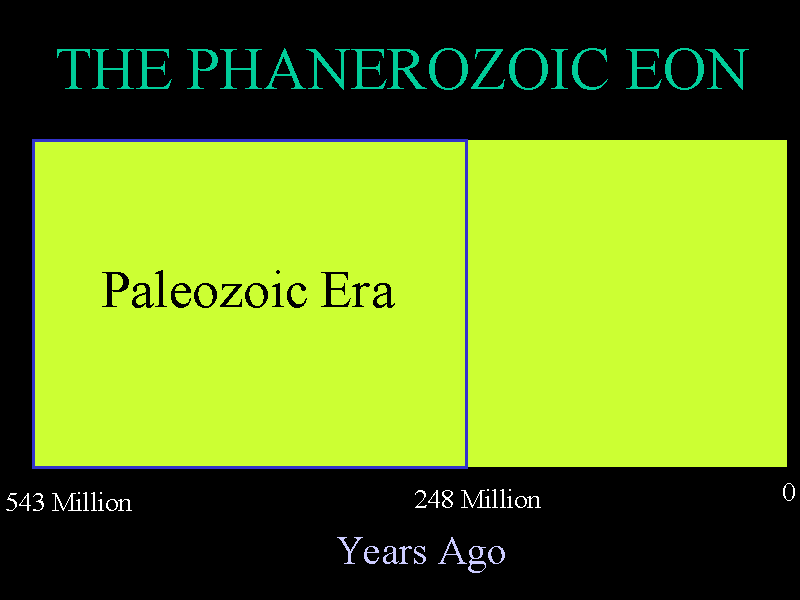 The Paleozoic Era (meaning "ancient life") lasted from 543 million
years ago until 248 million years ago. This era is further divided into
several periods:
The Paleozoic Era (meaning "ancient life") lasted from 543 million
years ago until 248 million years ago. This era is further divided into
several periods:
 the Cambrian, Ordovician,
Silurian, Devonian, Carboniferous, and Permian. It is during the early
Paleozoic Era that there was a tremendous increase in the evolution of complex
multicellular organisms (sometimes called the Cambrian explosion).
Many
of the types of plants and animals we are familiar with first appeared during
the Paleozoic Era, such as: jellyfish, coral, crabs, insects, spiders, fish,
amphibians, reptiles, ferns, and conifers. However, there were still no
people, no mammals, no birds, no flowering plants, and NO DINOSAURS! So
let's move on to the next era.
the Cambrian, Ordovician,
Silurian, Devonian, Carboniferous, and Permian. It is during the early
Paleozoic Era that there was a tremendous increase in the evolution of complex
multicellular organisms (sometimes called the Cambrian explosion).
Many
of the types of plants and animals we are familiar with first appeared during
the Paleozoic Era, such as: jellyfish, coral, crabs, insects, spiders, fish,
amphibians, reptiles, ferns, and conifers. However, there were still no
people, no mammals, no birds, no flowering plants, and NO DINOSAURS! So
let's move on to the next era.
The second era in the Phanerozoic Eon is the Mesozoic Era
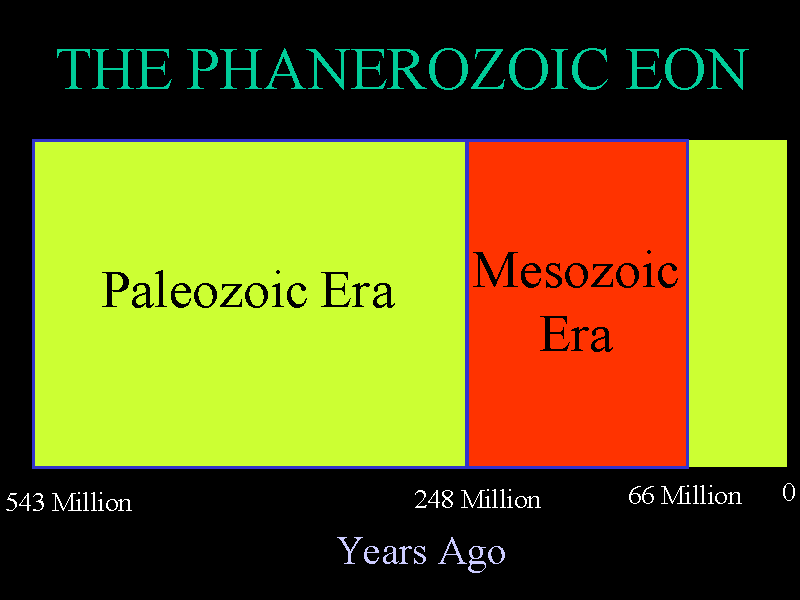 (meaning "middle life") which lasted from 248 million
years ago until 66 million years ago. The Mesozoic Era is often called the
"age of reptiles." It is during the Mesozoic Era that mammals, birds, and
flowering plants first evolved. It is also the era in which the ichthyosaurs,
plesiosaurs, pterosaurs, and most importantly for us, the
dinosaurs
lived! Even though mammals first appeared early in the Mesozoic, they didn't
evolve much beyond small rat-like creatures. In particular, there were no
bears, elephants, monkeys, and especially NO PEOPLE during the Mesozoic Era.
Before we explore the Mesozoic in more detail, let's look at the third and
final era in the Phanerozoic Eon.
(meaning "middle life") which lasted from 248 million
years ago until 66 million years ago. The Mesozoic Era is often called the
"age of reptiles." It is during the Mesozoic Era that mammals, birds, and
flowering plants first evolved. It is also the era in which the ichthyosaurs,
plesiosaurs, pterosaurs, and most importantly for us, the
dinosaurs
lived! Even though mammals first appeared early in the Mesozoic, they didn't
evolve much beyond small rat-like creatures. In particular, there were no
bears, elephants, monkeys, and especially NO PEOPLE during the Mesozoic Era.
Before we explore the Mesozoic in more detail, let's look at the third and
final era in the Phanerozoic Eon.
We live in the Cenozoic Era
which started
66 million years ago.
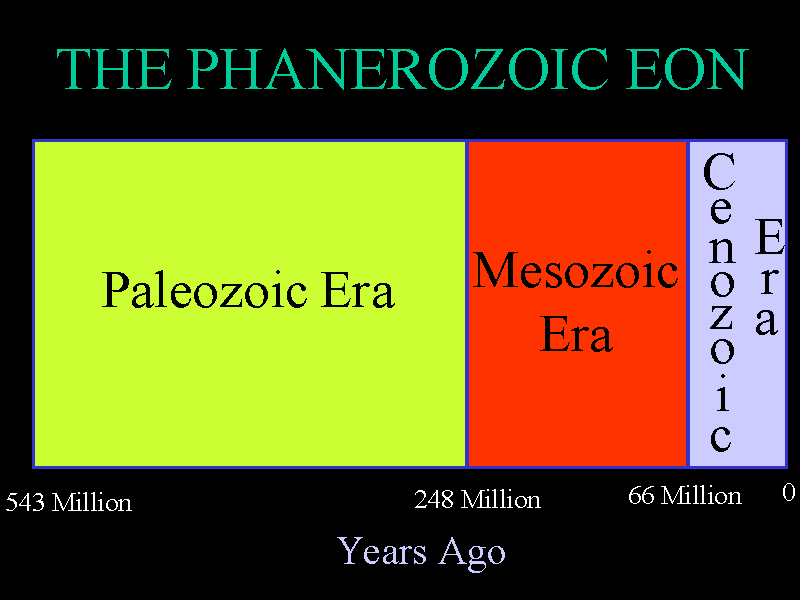 The Cenozoic Era is divided into two periods:
the Tertiary which lasted from 66 million years
ago to 2 million years ago, and the Quaternary.
The Cenozoic Era is divided into two periods:
the Tertiary which lasted from 66 million years
ago to 2 million years ago, and the Quaternary.
 These periods are
further divided into the epochs seen here. During these epochs, most of the
mammals with which we are familiar evolved including whales, bats, monkeys,
and humans. Some other strange mammals evolved and became extinct during
these times,
including the saber toothed tiger Smilodon, the rhinoceros-like
Teleoceras,
These periods are
further divided into the epochs seen here. During these epochs, most of the
mammals with which we are familiar evolved including whales, bats, monkeys,
and humans. Some other strange mammals evolved and became extinct during
these times,
including the saber toothed tiger Smilodon, the rhinoceros-like
Teleoceras,
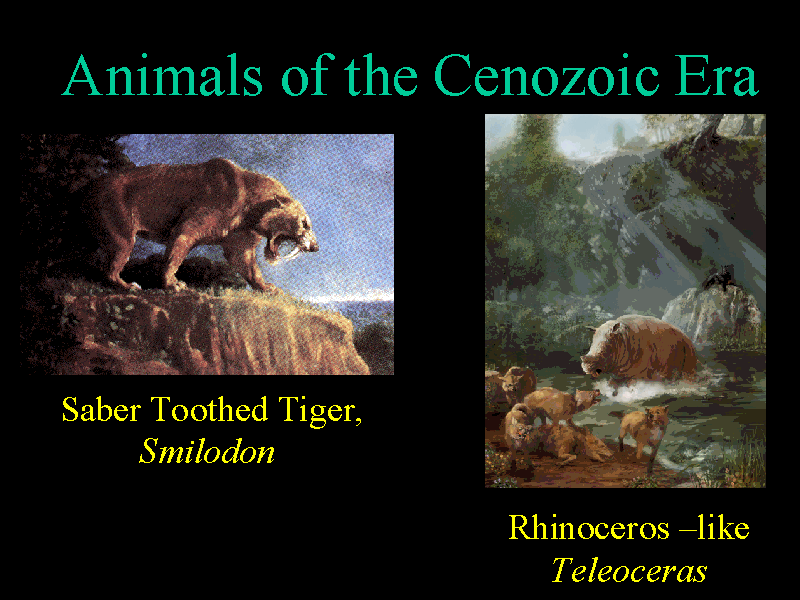 the "dawn horse" Hyracotherium (sometimes
called"eophippus") an ancestor of modern horses, and mammoths.
the "dawn horse" Hyracotherium (sometimes
called"eophippus") an ancestor of modern horses, and mammoths.
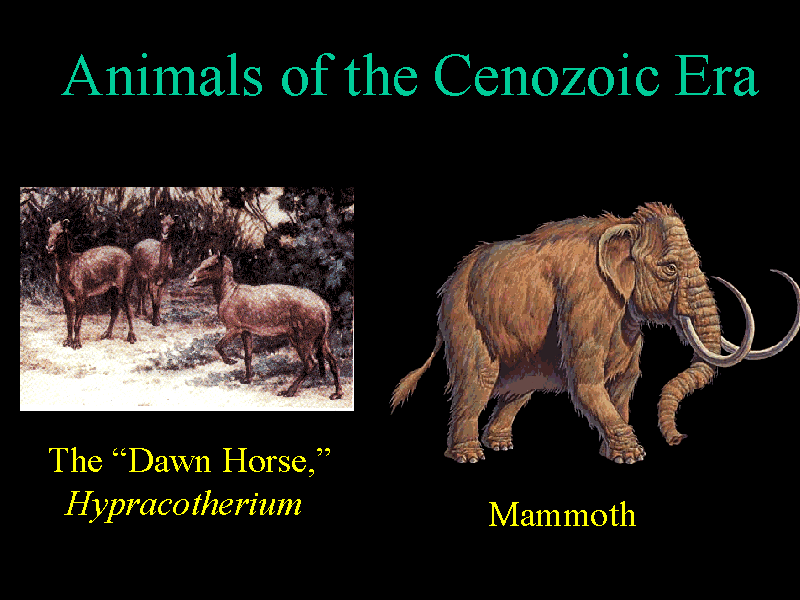 In fact,
some of these animals lived here in east Tennessee!
In fact,
some of these animals lived here in east Tennessee!
A particularly interesting group of animals evolved in the late Cenozoic:
the apes. Today, there are six groups of apes:
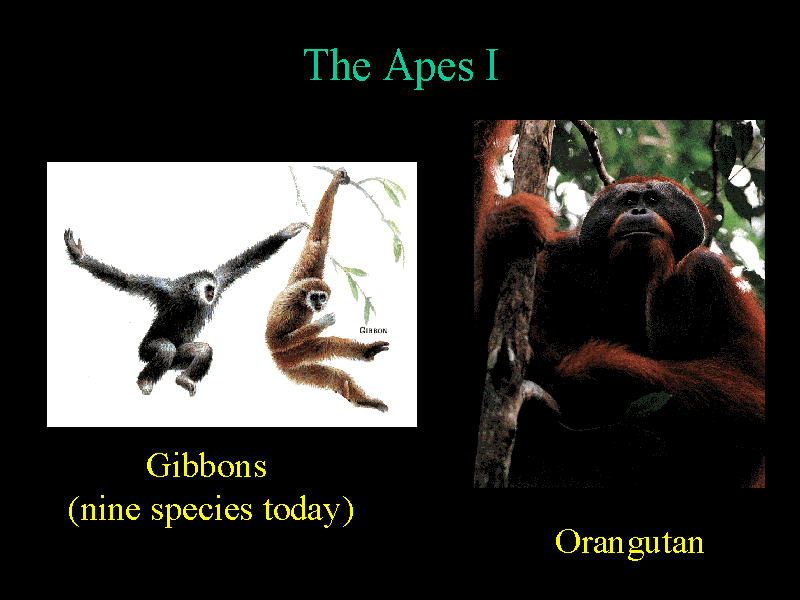 gibbons (of which there are nine species), orangutans,
gibbons (of which there are nine species), orangutans,
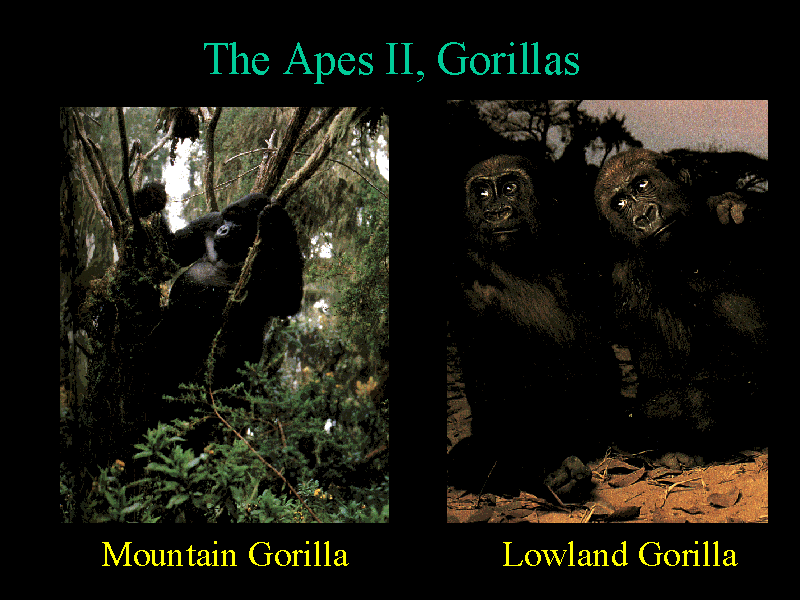 gorillas,
gorillas,
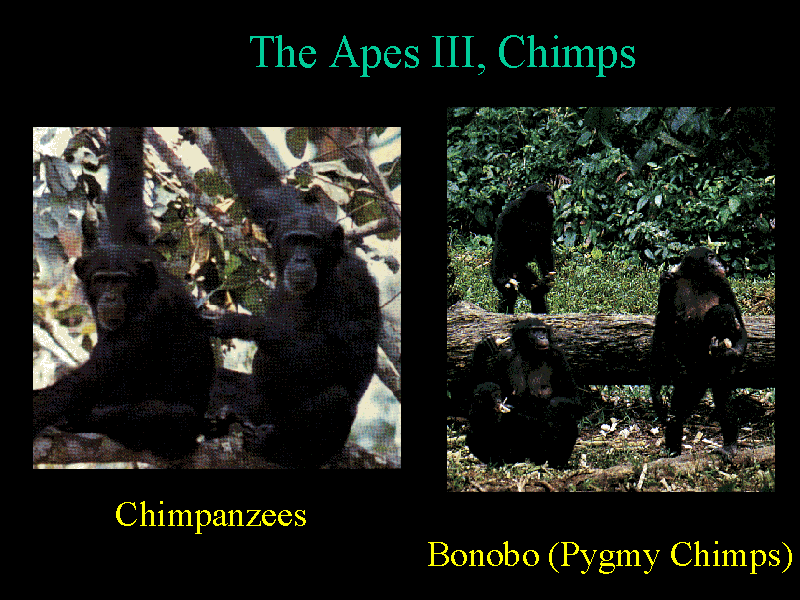 chimpanzees, bonobos (also called pygmy chimpanzees),
and humans. The evolutionary relationships between these animals is as seen
here.
chimpanzees, bonobos (also called pygmy chimpanzees),
and humans. The evolutionary relationships between these animals is as seen
here.
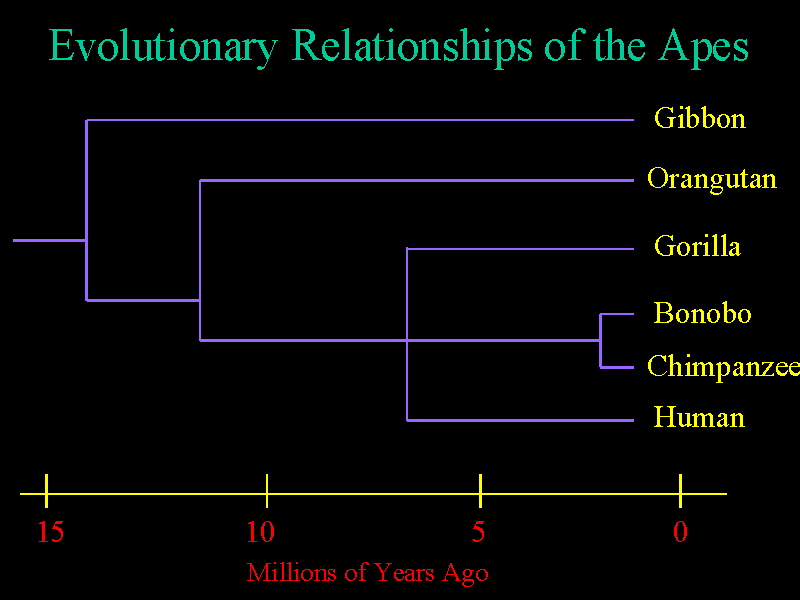 Gibbons and orangutans branched off long
before gorillas, chimpanzees, and humans. Humans branched off from the other
apes about 7 or 8 million years ago. Chimpanzees and bonobos became distinct
only about 1.5 million years ago. These dates are based on studies of both
anatomical and genetic differences. During the last 5 million years, several
very interesting species lived.
They include
Gibbons and orangutans branched off long
before gorillas, chimpanzees, and humans. Humans branched off from the other
apes about 7 or 8 million years ago. Chimpanzees and bonobos became distinct
only about 1.5 million years ago. These dates are based on studies of both
anatomical and genetic differences. During the last 5 million years, several
very interesting species lived.
They include
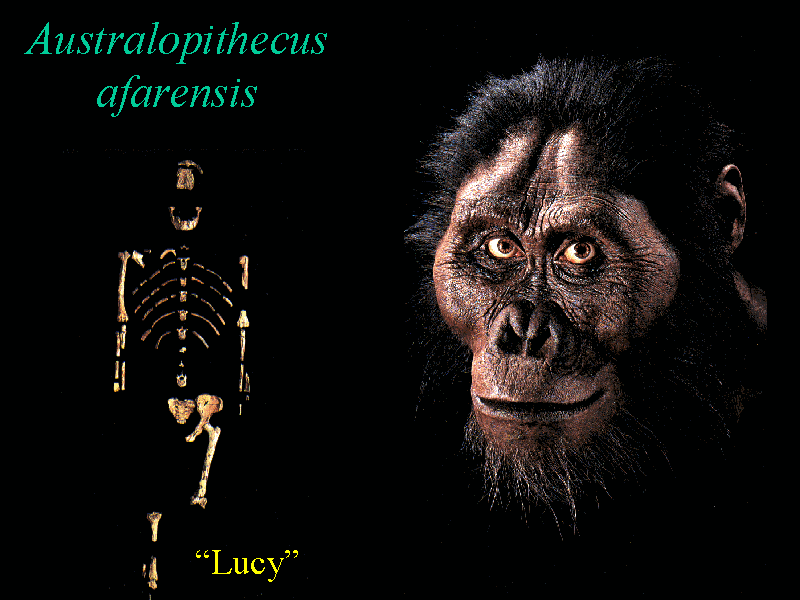 Australopithecus afarensis which lived from about
4 million years ago to about 3 million years ago,
Australopithecus afarensis which lived from about
4 million years ago to about 3 million years ago,
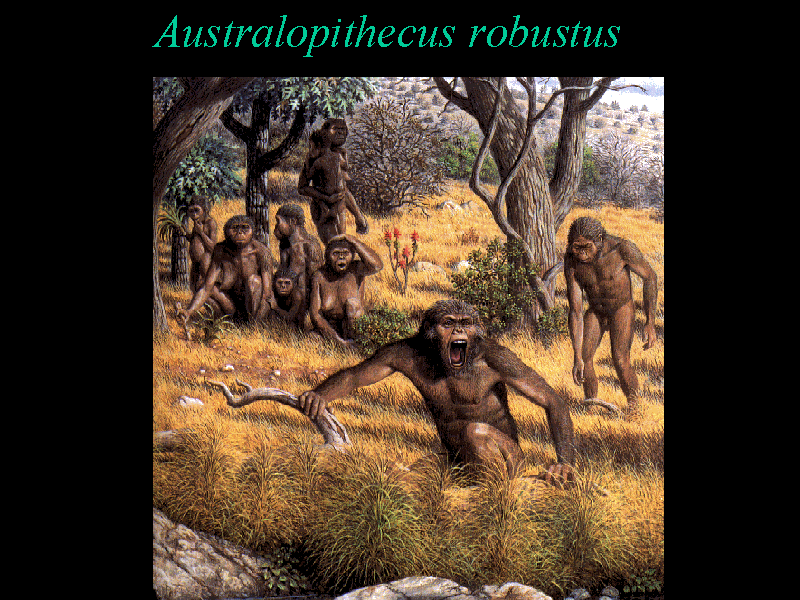 Australopithecus robustus which lived from 2 million
to 1 million years ago,
Australopithecus robustus which lived from 2 million
to 1 million years ago,
 Homo habilis which lived
from 2.5 million years ago until 1.6 million years ago,
Homo habilis which lived
from 2.5 million years ago until 1.6 million years ago,
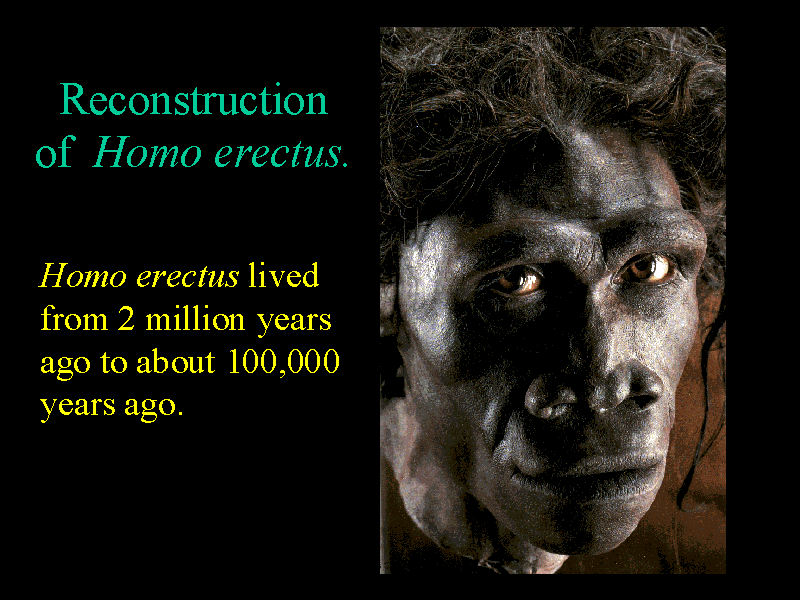 Homo erectus which lived from 1.8 million years ago to 100,000 years ago, and
Homo erectus which lived from 1.8 million years ago to 100,000 years ago, and
 Neandertals which lived from 230,000 years ago until 30,000
years ago.
What makes these animals so interesting is that they are our genetic
ancestors and our evolutionary cousins. These species represent a very small
part of the unbroken evolutionary tree from those first living organisms that
appeared 3.5 billion years ago to every living thing on planet Earth today,
including us!
Neandertals which lived from 230,000 years ago until 30,000
years ago.
What makes these animals so interesting is that they are our genetic
ancestors and our evolutionary cousins. These species represent a very small
part of the unbroken evolutionary tree from those first living organisms that
appeared 3.5 billion years ago to every living thing on planet Earth today,
including us!
Go to the next section.





















